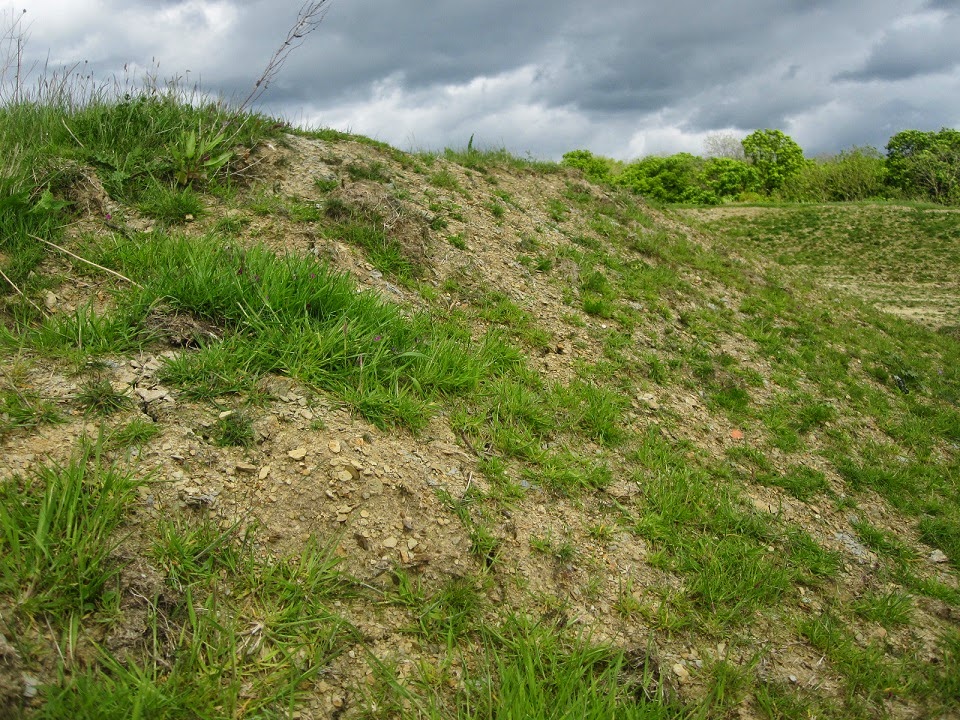Overlapping ecology surveys and a good dose of sleep deprivation means I'm a bit behind in blogging!
North West Zone aerial map
After a morning newt-surveying at the Nursery ponds (which turned up only 2 adult Great Crested Newts), mum and I headed off to check on the reptile mats. Just as we arrived, the weather switched from warm and sunny to cloudy and blustery. These rubbishy, changeable conditions have been standard this past month; frustrating when looking out for winged invertebrates. This is what we turned up...
Mother Shipton Moth (Callistege mi), named after a 16th century soothsayer-witch
Long-jawed Orb-weaver Spider (Tetragnatha extensa)
Glow Worm larva (Lampyris noctiluca). Actually a type of beetle and close to pupating
Black Clock or Necklace Ground Beetle (Pterostichus madidus), munching on a caterpillar
While checking the reptile refugia in the scrubby areas for any of our scaley guests, I realised that a couple of mats had gone missing... Subsequently, I've heard they were used as props under the wheels of a Land Rover which had got stuck in some mud nearby. I'm pretty confident that action would have failed and that our Grass Snakes would have benefited from them more!
Reptile refugia (roofing felt mat) - not for un-sticking trucks
So, at the end of a slightly truncated survey, we turned up three Grass Snakes: two less than 20cm long and a 1 meter, camera-shy individual. Its head was buried right down into its coils, in a case of I-can't-see-you you-can't-see-me.
Grass Snake (Natrix natrix)
Shepherd's Purse (Capsella bursa-pastoris) seed pods
Shepherd's Purse (Capsella bursa-pastoris) flowers
Until I heard that magic word: 'Bees!!'
But this ain't just any type of Bee. Oh no my friend.
Long-horned Bee (Eucera longicornis) males
This is is the Long-horned Bee, Eucera longicornis; a very scarce species in Britain and we did not only find one, but a small community! Their antennae are extraordinarily long which makes them very distinctive, and laughably cute like little cartoon characters.
NBN Gateway Distribution
As you can see from the above map, their distribution is very limited and there are very few records since 2000. The designation for this species is Nationally Notable A, which means rare and scarce. It is also UK BAP priority species, meaning it needs some conservation action to help it out, so we will be updating our Biodiversity Action Plan with some new targets!
Look at that face!! I think they look like some kind of Pokemon
Judging from Jeremy's excitement (that would be very excited indeed), this is one of the best species to have stumbled across in our fair isles. It loves high quality, flower rich grasslands for foraging and clay areas for nesting, which we have in abundance along the sculpted River Mole floodplain. We counted at least 10 of these little guys, possibly even more buzzing around the wildflowers below the clay slope. They will be nectar feeding on the plentiful vetches, meadow vetchling, clover and trefoils.
Difficult to snap as they were eagerly chasing each other around, as well as any poor, unsuspecting Damselflies and Butterflies
My photos don't do this gorgeous little beastie much justice, so here are a couple of Jeremy's which were taken in the past few weeks over at another site...
Long-horned Bee (Eucera longicornis) male. Photo by Jeremy Early
Long-horned Bee (Eucera longicornis) male. Photo by Jeremy Early
Once this annoying weather starts behaving again, I'll be back up on that slope trying to spot our first female!


















.jpg)





































